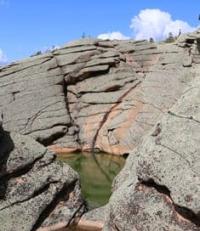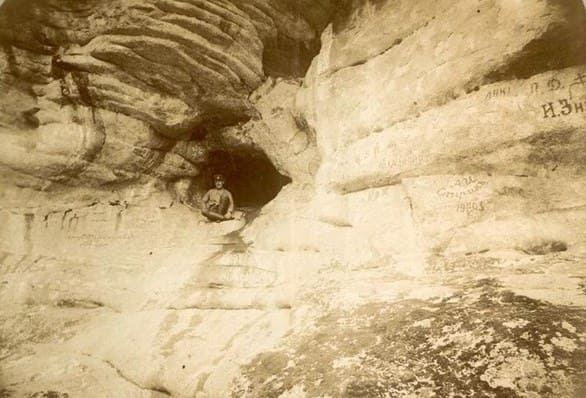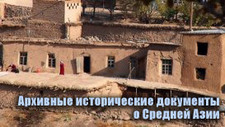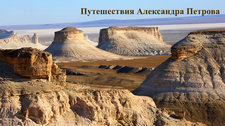You are here
Caves in Karkaraly Mountains.

Visiting caves in Karkaraly Mountains.
"At the beginning of the Kyzyl-Kench Gorge, in a low mountain, there is a cave, in front of which, below, stand enormous granite boulders." The largest of them is 25 fathoms in circumference and at least 7 fathoms high. The cave is much smaller than the Bayan-Aul Aulie-Tas. Various rags hang on the bushes near it, and ram bones are scattered around: here, near the stones, rams are boiled, and in the cave itself, they burn chirak (As I was told in Kent, those Kyrgyz who have become more closely acquainted with the Muslim faith, although they visit the cave, do not light candles in it, considering it a sin). The cave is visited for prayer by the sick, the poor, and mainly childless women. After prayers in the Kyzyl-Kench cave, according to the belief of the Kyrgyz, mostly girls are born, which is why the cave was named Kyz-Auliye-Tas or, abbreviated, Aulie-Kyz (Kyz - girl).
N. Ya. Konshin. "From Pavlodar to Karkaraly." 1901.
Tours to Karkaraly Caves.
Karkaraly Mountains, located in the eastern part of the Karaganda region of Kazakhstan, have long attracted the attention of explorers, travelers, and nature lovers. These picturesque places are famous not only for their pine forests, lakes, and granite massifs, but also for their caves, each of which holds an ancient secret.
The Karkaraly Mountains have an abundance of caves which relate to different periods of human history. Those caves to the north of the town of Karkaralinsk are the most popular with visitors. Among them there are the caves inhabited in the Bronze Age and some with signs of relatively recent occupation.
The former are represented by the so-called Gorge Caves (Ravine of Caves), with numerous springs. The most famous among the modern caves is the cave Bolshaya Palatka (the Huge Tent) which is a source of curiosity for those with an interest in recent history.
It comprises a 10 meter deep cavity in the rock, some 8 meters high and 15 - 20 meters in width. This cave is considered a house-register of Karkaraly, for its walls are covered with lots of inscriptions, most of which date back to the early XXth century.
Well-known names can be found there alongside the names of ordinary tourists who visited this place during the last century.
Natural features and cave formation in Karkaraly Mountains.
The caves of the Karkaraly Mountains are primarily of granite fissure origin. Unlike karst areas, where voids form in limestone and dolomite, the caves here were formed by weathering, tectonic faults, and erosion. Despite their relatively small size, they possess a special charm and are often associated with legends and tales of local residents.
The Karkaraly Mountains are home to natural attractions associated with caves, particularly the "Three Caves" complex and the "Big Chamber" (also known as the Cave of the Big Chambers), which are popular tourist attractions within the Karkaraly National Park.
In the three caves of the Maliksay valley, one can see the crystalline facets of rock crystal and topaz glittering in the light. Smoky and wine-yellow topaz were previously found here. This likely refers to the leftmost cave, renowned for its rich mineral deposits.
The high mountains form a true mountain oasis amidst the Saryarka hills. Not far from Soroka Lakes are the remains of a quarry where, until several decades ago, various gemstones were mined, including chrysoprase, amethyst, morion, quartz, and others.
The remains of the quarry are impressive caves, where, with sufficient persistence, gemstones can still be chipped from the walls or picked from the ground.
Main caves of Karkaraly Mountains and their features.
"Ungirtas" is a natural crevice in a granite cliff in the northeastern Karkaraly Mountains, 2 kilometers north of the town of Karkaraly. The cave is 4 - 5 meters high, 15 - 20 meters wide, and approximately 8-10 meters long. Large boulders are located under the dome.
The upper part of the cave is composed of stones that repeatedly reflect the echo. Ungirtas Cave is considered a tourist attraction.
"Three Caves" is a group of small caves located within the park, attracting tourists with their natural beauty and accessibility.
"Big Chamber" is a larger and more impressive cave, which is also part of the national park's tourist infrastructure. These caves are part of the natural heritage of the Karkaraly region, which also boasts other attractions such as Lake Shaitankol and Zhirensakal Peak.
"Kent-Karagay Cave", the most famous cave in the Karkaraly Mountains is located near the ancient Kent mine. It is a fissure in the granite rock, reaching depths of several tens of meters. In ancient times, the cave served as a refuge for nomads, and, according to legend, as a secret storage place for valuables.
The Karkaraly Mountains have an abundance of caves which relate to different periods of human history. Those caves to the north of the town of Karkaralinsk are the most popular with visitors. Among them there are the caves inhabited in the Bronze Age and some with signs of relatively recent occupation.
The former are represented by the so-called Gorge Caves (Ravine of Caves), with numerous springs. The most famous among the modern caves is the cave Bolshaya Palatka (the Huge Tent) which is a source of curiosity for those with an interest in recent history.
It comprises a 10 meter deep cavity in the rock, some 8 meters high and 15 - 20 meters in width. This cave is considered a house-register of Karkaraly, for its walls are covered with lots of inscriptions, most of which date back to the early XXth century. Well-known names can be found there alongside the names of ordinary tourists who visited this place during the last century.
"Ayuly Cave", cave's name derives from the bears (ayu means "bear") that often found shelter here in ancient times. The cave is small in size, but has a distinctive wide entrance and cool air even in hot weather. Today, it attracts tourists as a short walk.
"Small Caves of Karkaraly Massif", in addition to the large caves, the mountains contain numerous smaller caves, crevices, and grottoes, many of which remain poorly explored. They form on the slopes of granite outliers and in valleys where active rock erosion occurs. Some of them are difficult to access, but this is precisely what makes them particularly attractive to adventurers.
Legends and Folklore of Karkaraly Caves.
The Karkaraly Caves are shrouded in myth. According to one legend, the spirits of ancestors lurk in the depths of the mountains, protecting the land from ill-wishers. Another story tells of a brave warrior who escaped from enemies in a cave and, disappearing into its depths, was never found. Locals believe that on quiet nights, echoes of ancient voices can be heard at the entrances to some grottoes.
Karkaraly Mountain Caves as Tourist Attractions
Today, the caves of the Karkaraly Mountains are included in tourist routes visiting the Karkaraly Nature Park. They are interesting not only from a geological perspective, but also as part of the region's cultural heritage. It is important for tourists to keep in mind that many caves have difficult-to-reach entrances, so it is recommended to visit them accompanied by experienced guides.
The best time for exploring is the warm season from May to September. The cave entrances are cool and damp, so even in summer, it is advisable to bring warm clothing and a flashlight.
Significance of Caves in Karkaraly Mountains.
The caves of the Karkaraly Mountains are not only natural monuments but also a living part of history. They preserve traces of ancient nomads, the secrets of legends, and the beauty of untouched nature. For researchers, this is an important source of knowledge about the region's geology and archeology, and for travelers, it's a place to encounter the mysterious and beautiful world of the mountain depths.

Authority:
Alexander Petrov.
Photos by:
https://rus-turk.livejournal.com/749123.html







